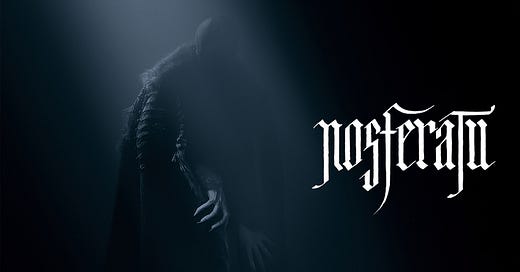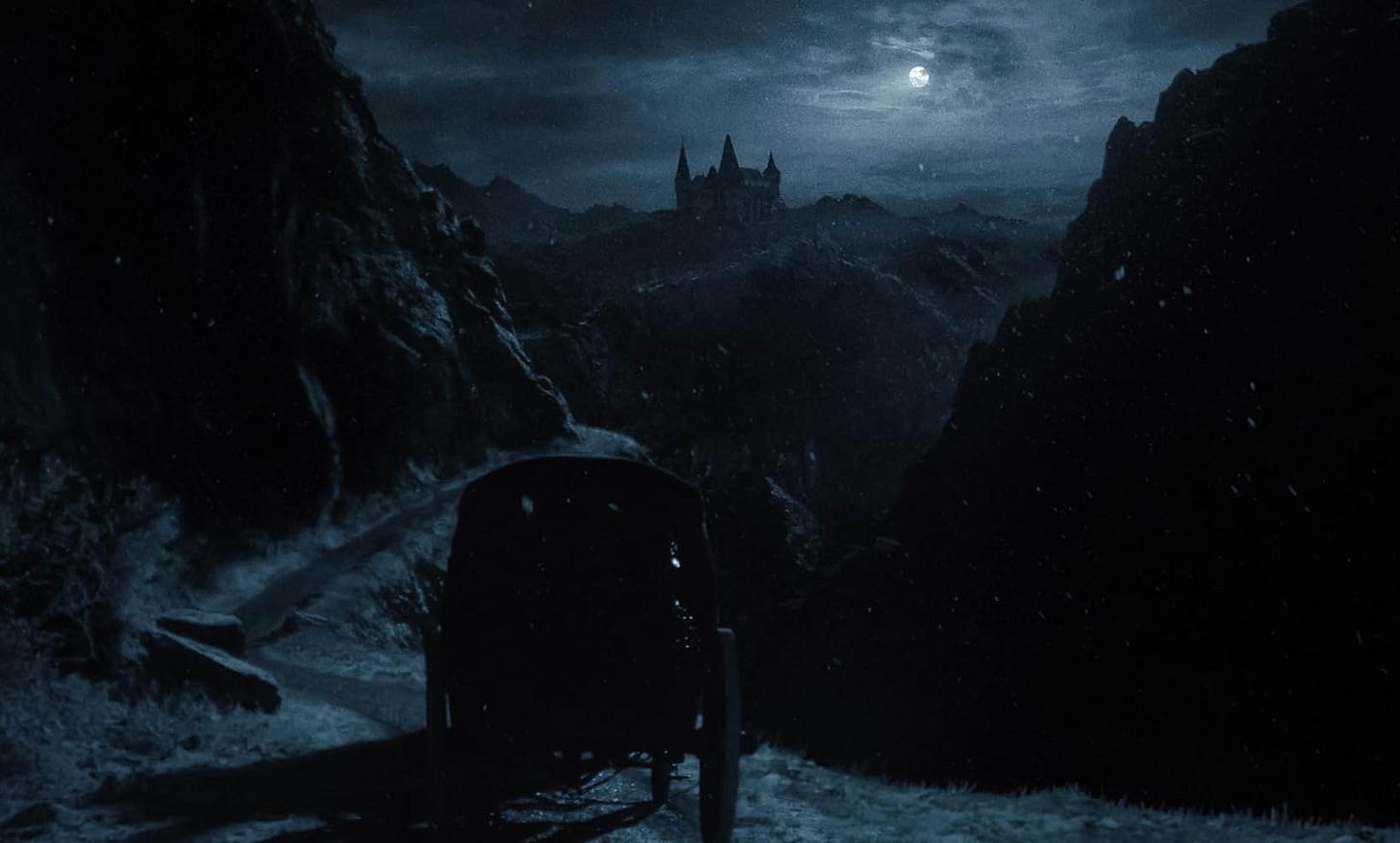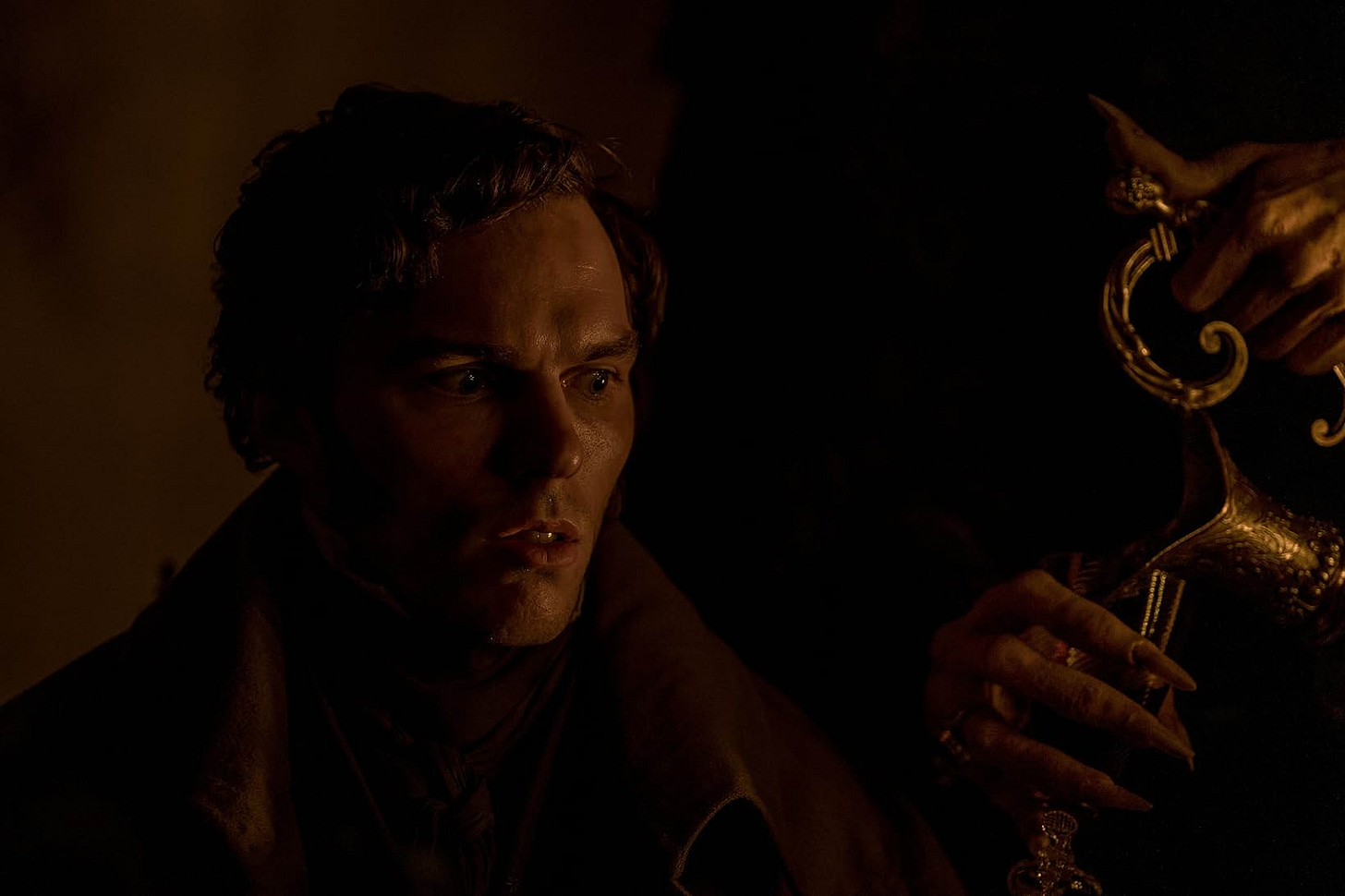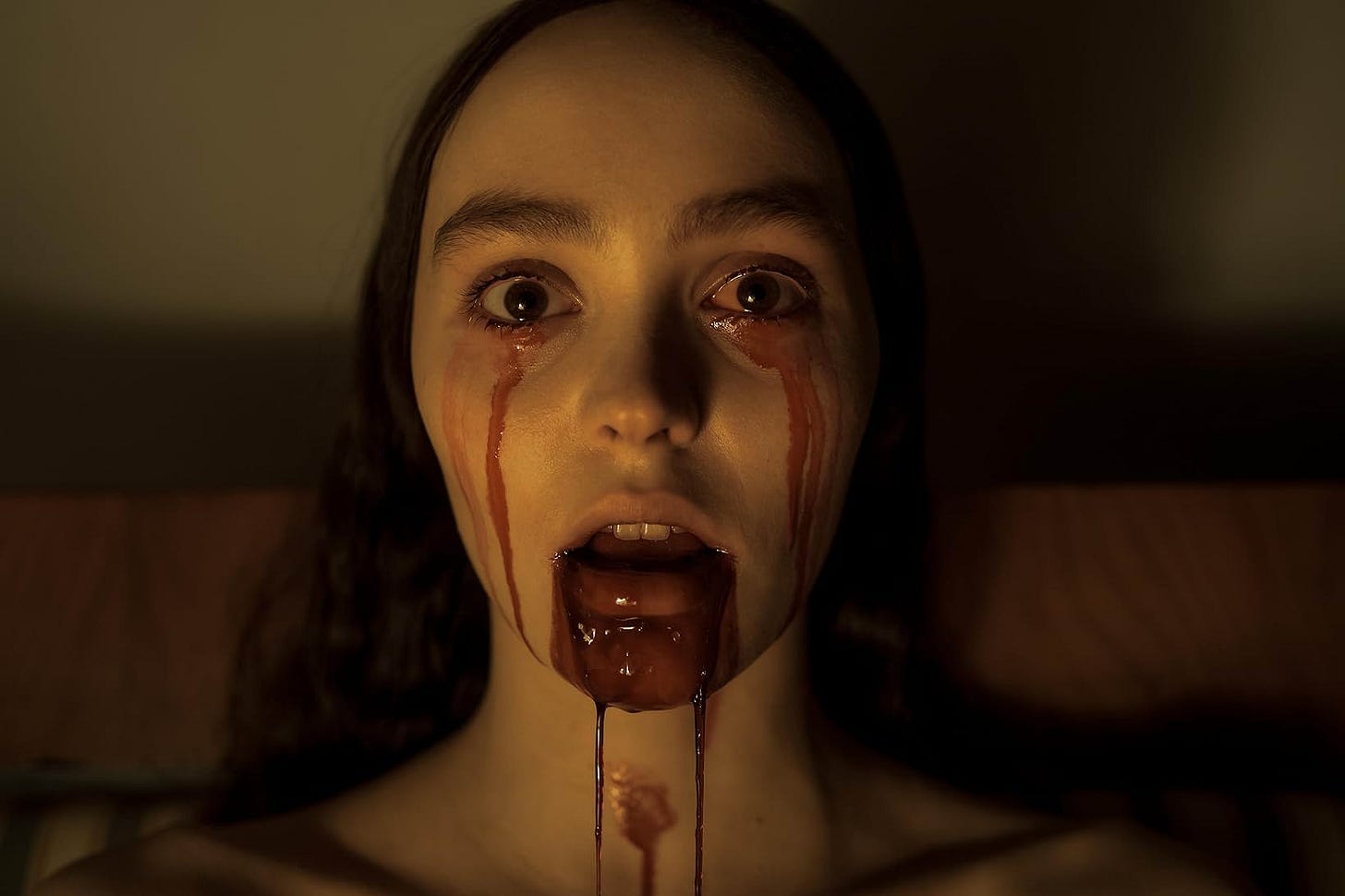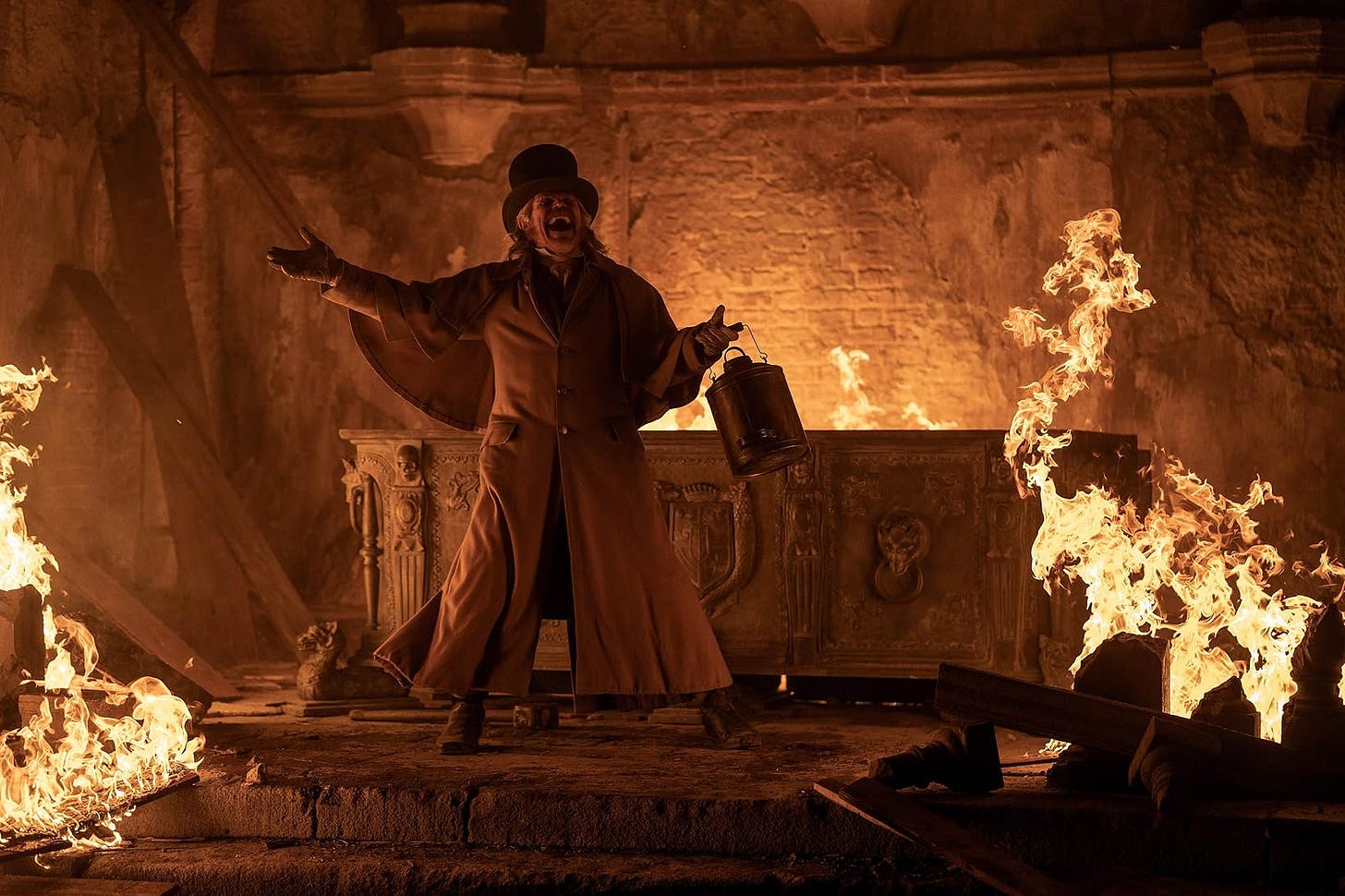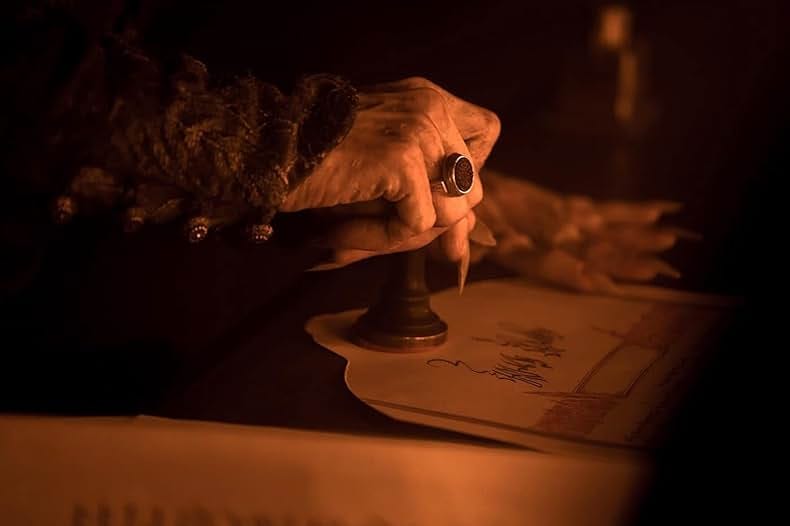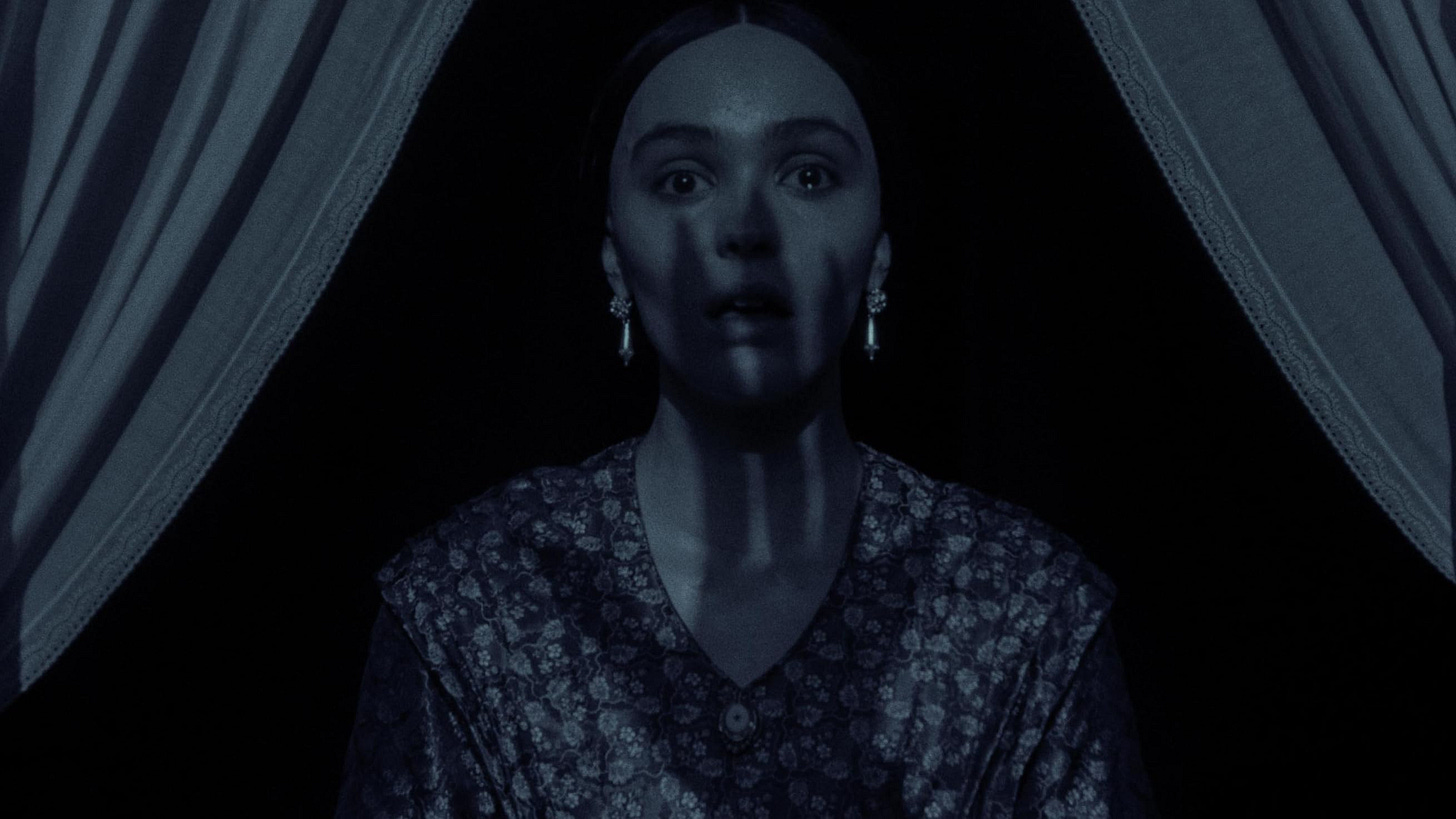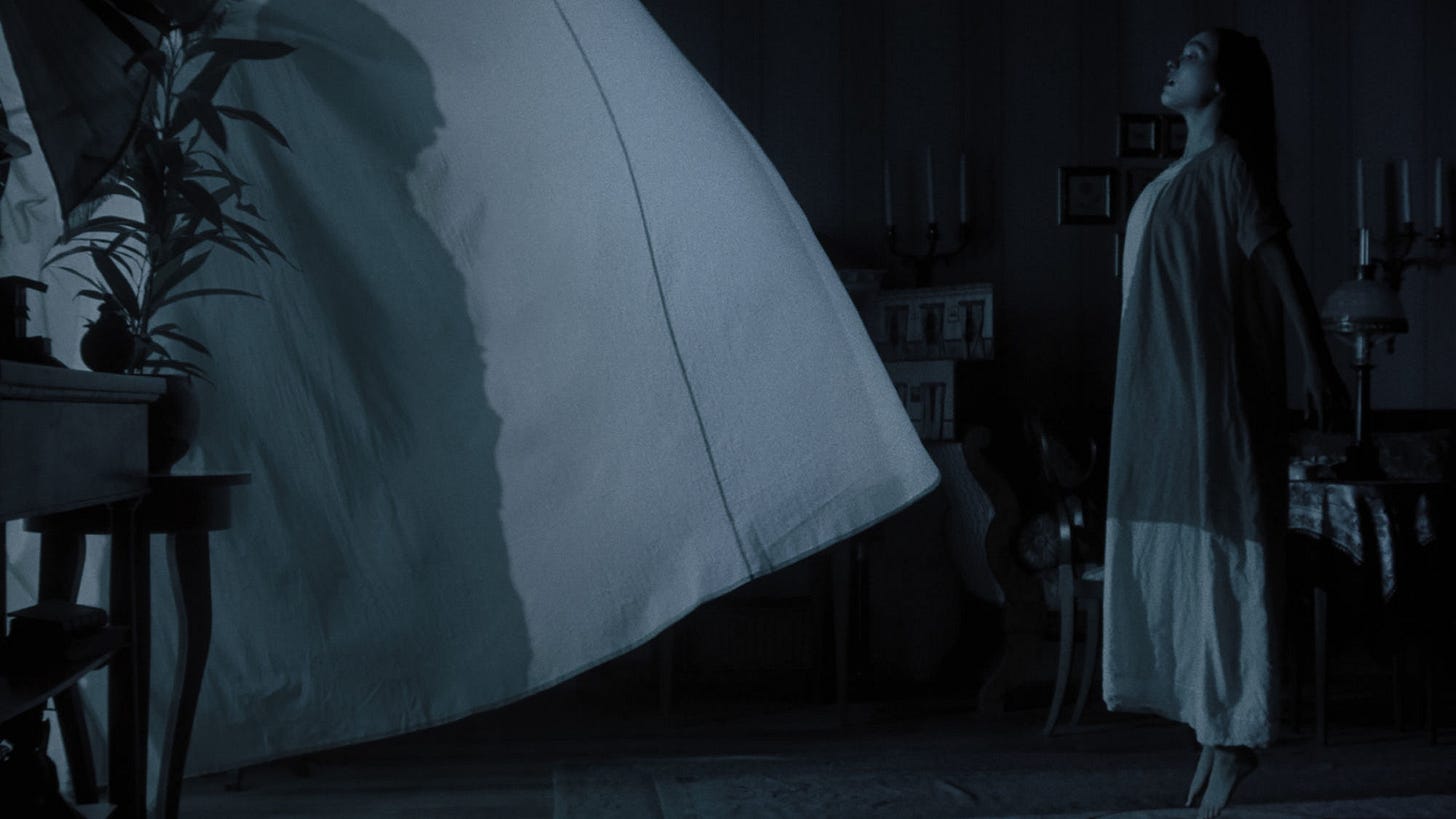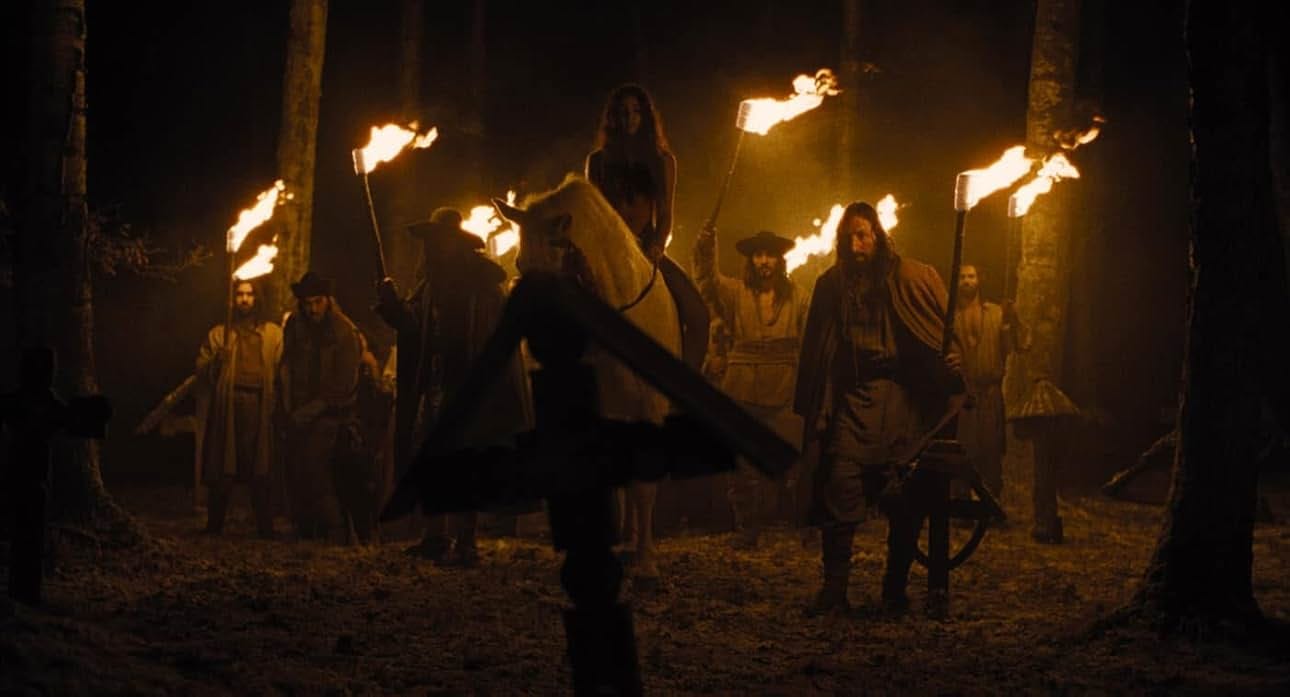CURRENTLY WATCHING: Nosferatu
Or, the time one girl was so horny she brought the plague to Germany.
I love vampires. I loooove vampires. And I love gothic horror, and I love movies. So! I went into Robert Eggers’s long-awaited Nosferatu with such high expectations, I felt almost certain the film itself would inevitably disappoint.
Reader, I am delighted to report, it did not.
The design is gorgeous. The cinematography is breathtaking. The opening scene is one of horror’s best since It Follows (David Robert Mitchell, 2014). It will come as a surprise to no one that I loved Nicholas Hoult’s performance in this, but it’s truly been a while since I’ve seen a person look so genuinely terrified on film. Willem Dafoe1 is having a ball. Bill Skarsgård is captivating. Aaron Taylor-Johnson is equal parts absurdly uptight and genuinely heartbreaking. And lead actress Lily-Rose Depp delivers an intense and gut-punching performance, particularly in the back half of the film, that puts her right up there with some of horror’s greatest heroines.2
It's a five-star film for me; even with my qualms and quibbles, it’s just so epic and daring in scope and atmosphere that it feels impossible to view it as anything less. It’s haunting and macabre, gross and visceral, surprisingly funny and deeply horny. There’s occasionally a bit of a The Muppet Christmas Carol vibe happening. In short: it’s everything a vampire movie should be and then some.
A FIVE-STAR FILM
Nosferatu is an adaptation of a 1922 German expressionist silent film from F. W. Murnau, which is in turn an (unauthorized) adaptation of Bram Stoker’s Dracula. The film has been a long-time passion project of director and writer Robert Eggers and has been in the works since the release of his 2015 debut The Witch.
“I saw a picture of Max Schreck as Count Orlok in a book in my elementary school and I lost my mind.” - Robert Eggers, IndieWire (2024)
The story is familiar. In 1838, estate agent Thomas Hutter (Nicholas Hoult) leaves his new wife Ellen (Lily-Rose Depp) to meet with a strange and reclusive potential client — Count Orlok (Bill Skarsgård) — who resides in a castle in the mountains of Transylvania (*lightning crash* *lightning crash*). A series of bizarre events rapidly unfolds, including waking nightmares, unexplained bite marks, and a truly ungodly number of rats. We quickly learn that Count Orlok is more than an eccentric old noble, but rather, an ancient demon, a vampire, and, most importantly, Ellen’s obsessive ex-boyfriend. Orlok is intent on traveling to Germany to reclaim his bride. Chaos, bloodshed, and even more rats3 ensue.
The production design of this film is absolutely exquisite. Whether we’re in the crumbling remains of a lavish Romanian castle or dashing through the streets of a cramped, 19th century German city, the verisimilitude of the film is truly unmatched.
“We built everything, basically. Even the cemetery—we built the mausoleum, and we brought in 30 of our own headstones, to make it what it needed to be for this film.” – Robert Eggers, Deadline (2024)
The cinematography of the film is equally as sweeping, earning cinematographer Jarin Blaschke the National Board of Review’s 2024 award for Outstanding achievement in Cinematography. The composition of each shot is meticulous and crisp, emphasizing shadows, silhouettes, and doubles in nearly every frame. Homages to classic horror cinema abound — from the original Nosferatu (of course) to The Exorcist — and yet the film has an eerie, melancholy, yet incredibly precise flavor to its visual aesthetic that feels wholly its own.
In a recent interview with Gizmodo, Eggers mentions his attempt to make the film’s many long, unbroken takes feel a bit more seamless and invisible to the casual viewer. I’m not sure he is entirely successful in this gambit4 — I found myself paying close and frequent attention to the movement of the camera— but I actually think this was to the film’s benefit. There are countless moments in the film where attention is drawn to the camera’s independent movement, especially in the scenes where Thomas explores Nosferatu’s castle. Either we’re following Thomas and then abruptly stop while he walks out of frame or the opposite — Thomas stops and we push ahead — but in either case, this disconnect of the camera’s perspective from our central characters adds to the sense of unease and discomfort that permeates this film and also helps untether the viewer from any grounding in reality in these fever-dream-like sequences. I can’t quite trust the camera’s authority — that is, what I’m seeing may not be true — and at the same time, the way the camera’s movement draws attention to its own apparatus adds the lingering feeling that there’s another presence in the room, something — or someone — constantly watching.
“There’s a wonderful moment where, through some camera trickery, Bill’s standing at the end of the table, and then it pans over to me, and then he’s moved around, and he’s actually peering right over my shoulder. There are these beautiful moments where there’s all these things that add up to being like, ‘Oh, this is horrible, and weird, and I should get out of there,’ but, in the moment, because you can’t quite tell what’s happening, it’s kind of spooky, and the tension builds better through that.” – Nicholas Hoult, Deadline (2024)
While her husband navigates an increasingly dangerous encounter with Orlok in Transylvania, Ellen endures her own nightmare back home in Germany. We are told that she has long suffered from nightmares, fits of sleepwalking, and seizures, and these conditions worsen significantly once Thomas leaves home. Soon, Ellen is captured by a textbook demonic possession, giving Lily-Rose Depp the opportunity to act her pants off. We’re talking foaming at the mouth, eyes white, full back bend levels of “your mother sucks cocks in hell” type activity here. And very little of this action is CGI, according to Eggers. Instead, he brought in choreographer Marie-Gabrielle Rotie to train Depp in the foundations of butoh, a Japanese dance-theater practice that emphasizes slow movements, contorted faces, and grotesque imagery. Eggers drew inspiration from this art form for scenes in his debut film The Witch, and he also used this as the basis for many of the possession scenes in Nosferatu.
Throughout her suffering, Ellen is staying with wealthy friends Anna and Friedrich Harding (Emma Corrin and Aaron Taylor-Johnson). Taylor-Johnson’s performance provides a grounded and often comical counterpoint to the fantastical tortures Hoult and Depp’s characters endure, and I found one of our most endearing side characters in an ensemble of truly delightful side characters, including an eccentric occultist played exquisitely by Willem Dafoe, an obsessed devotee of Orlok who eats a pigeon on screen, and the Harding’s two adorably doomed young daughters who are terrified of the monster that lives under their bed.5
“I was very happy when [Eggers] proposed this role of Von Franz, because clearly it was a role that was a guilty pleasure for him. And once upon a time he was an actor, and I felt very strongly that this is the role he would play if he weren’t directing.” – Willem Dafoe, Deadline (2024)
Worth mentioning: this movie is surprisingly funny at times, often when Dafoe is onscreen; I laughed far more than I remember laughing at any of Eggers’ previous films. I’ve seen a few reviews that mark this as a negative, decrying melodramatic acting and unmoored performances, but I’m choosing to view it as intentional. I think it works well, juxtaposing the absurdity of the scenario to a nonbeliever like Harding with the very real, very scary threat of Nosferatu to great effect.
Also, did I mention that Nicholas Hoult is very good in this? I just think it should be noted that he is very good in this, and if we’re going to nominate Hugh Grant for Heretic we really ought to have at least one of this film’s stellar ensemble on an awards list this year.
“[Hoult] has both this incredible, naturalistic, emotional thing, and then he can handle the period language, and really communicate it effortlessly. And he has a great look for it and a great feel for it.” – Robert Eggers, Deadline (2024)6
And then, of course, we have the vampire… Nosferatu!
I KNOW WHAT YOU ARE (… say it…)
When I first saw Bill Skarsgård attached to this film as Count Orlok, I will admit, I was actually a little underwhelmed. Not because I don’t appreciate Skarsgård’s impressive filmography, but rather because I do. Of course you cast Bill Skarsgård as Nosferatu. That’s such an obvious choice. And it was that very obviousness that made me hesitate. What’s new and interesting about that casting? What is it going to show me about the character that I don’t already know?
And as it turns out, my mistake was in asking those very questions. Skarsgård’s Orlok— indeed, the entire film itself — is not a “new” spin on the character or the story. Rather it’s a deep dive into the things that made this original premise so lastingly frightening. It’s an homage to and an explosion of our most visceral human fears, and it’s never *trying* to be shiny or metaphorical or (*sigh*) elevated, it’s just trying to be truthful to the essence of the myth itself.
“I can’t do Max Schreck again, so it’s going back to the origins of the folk vampire.” – Robert Eggers, IndieWire (2024)
Aesthetically, Skarsgård’s Orlok is sort of a zombified take on a historically accurate 200-year-old Transylvanian nobleman. We still get hints of Max Schreck’s iconic vampire from the 1922 silent film — the bald head, the stiletto fingernails, the hulking shoulders — but the overall look is shockingly… human.
“[Skarsgård] was genuinely petrifying-looking. The way they made his skin look and feel, the costume, the whole thing—feels so real, and it feels like a total nightmare. That’s what I think is so unsettling about it: it’s not just like looking at a monster; it’s like there’s something very human about him, which I think makes it all the more terrifying.” – Lily-Rose Depp, Deadline (2024)
In performance, too, Skarsgård walks a brilliant line between the horrific and the human. His Orlok is terrifying, with a deep, grating voice interrupted by doglike, wheezing gasps for air. And yet there’s something alluring about the intensity of his gaze, the strength of his speech…7
“Rob had a recording of Bill’s voice, and that was fascinating, because even through just a phone speaker in the rehearsal room, it was like it got through to your bones, and it was unexpected, but then made perfect sense. You’re like, ‘Oh, of course that’s how he would sound if he was this nobleman who had been dead for 200 years.’ It was otherworldly, but rounded in history, and truth, and so that was exciting.” – Nicholas Hoult, Deadline (2024)
The make-up and prosthetics for Orlok are stunning as well. There’s something about the combination of thick mustache with his peeling, decaying skin that really got to me, especially in the moments when he and Ellen come close to embracing. You can almost smell the centuries of rot and filth that must be emanating from his body,8 and yet you can’t quite convince yourself to want Ellen to pull away, at least not just yet…
“He’s the romantic lead, isn’t he [laughs]? Yeah, it’s tricky. Is he a villain? Yeah, of course; I mean, he’s Nosferatu, he’s Dracula, he’s one of the most, if not the most iconic horror villain there is. But I think the script has nuances that make it more complex, more layered.” – Bill Skarsgård, Fangoria (2024)
Apparently, the process of creating this iconic horror character was daunting, even for a genre legend like Skarsgård. Robert Eggers reportedly wrote a novella in preparation for the film that went into great detail regarding Orlok’s backstory, which he gave to Skarsgård to study prior to shooting. While this backstory is blessedly absent from the film proper, Skarsgård’s performance makes it eminently clear that wherever this creature came from, his longing, his lust, and his ferocity are deeply real.
“I became very obsessed… I was so in that mind state that I felt this is pure evil. I felt that the movie was evil. I think it felt like we were doing some sort of evil, dark, magic sorcery at times. I certainly don’t feel that way about the movie now that it’s complete. I think it’s actually beautiful. It’s scary and it’s horrific, but there’s also a lot of beauty in it. And it’s sensual and sexual and it hits on so many different layers. But in terms of reaching out as far as humanly possible away from yourself, and gathering whatever it is that you can gather, and just transforming yourself, this is, I think, probably as far as I’ll go in my entire career.” – Bill Skarsgård, Deadline (2024)
As a director, I would not say that I endorse becoming so entrenched in a character that you begin to feel that the project itself is evil. That’s why we have tools like de-roling. That said, I’m glad Skarsgård has been able to leave the world of the Count behind while also gifting us with an incredible performance.
FACE YOUR FEARS
In the creation of this script and its eponymous villain, Eggers wanted to strip back decades of cinematic iconography and Halloween costumes and return to the original roots of the vampire legend.
“I needed to be disciplined to forget what I knew. And then, you start looking at the really early vampire accounts, and you’re like, ‘They’re not even drinking blood, they’re just strangling people, or suffocating people, or fucking them to death.’ And that was really interesting.” – Eggers, Deadline (2024)
We see a handful of these variations in the film. For example, Eggers’ vampire drains its victims by sucking blood from their chests rather than their necks; they are killed not by impalement through the heart, but through the abdomen.
We also see Eggers explore a number of the very real fears and obsessions that have fueled vampire-lore throughout human history, including the plague, sexual purity, foreign cultures, and more.9
The sexual threat of Nosferatu is the most explicit textually in the film, as well as aesthetically. Count Orlok is the ultimate masculine presence in the film; we see his silhouette more often than we see his actual form, and oh boy is that silhouette phallic. In Germany, we see soft cats surround characters like Thomas and Willem Dafoe’s occultist, whereas Orlok’s domain is dominated by vicious dogs. Nicholas Hoult’s clean-shaven, stylishly-dressed Thomas is immediately overshadowed by the hulking, fur-wearing, heavily mustached male figure of Orlok, who first steals Thomas’s wife and then proceeds to penetrate Thomas repeatedly (with his fangs). Their whole dynamic in this film is a literal contest of “who’s going to penetrate whom.”
Fascinatingly, the first shot we see of Orlok, he’s standing in silhouette opposite Thomas — becoming Thomas’s reflection, or shadow. Perhaps his lost masculinity? His repressed id? The sexual repression that haunts Ellen’s story is obvious and clear. We know women of that time period (and this one, in many ways) were not allowed to express their sexual needs and desires, these desires were seen as sinful and shameful, etc. But this film is also very clear in its understanding that these fears and repressions of sexual desire go beyond gender — Thomas, too, is repressed, and that repression is also a problem for the narrative.
“Talking about the sexuality, there’s also that interesting moment where Ellen says, whilst under some sort of possession, ‘You could never satisfy me like he could.’ There’s this element, I think, with Thomas where, because he is so good-natured and pure in many ways, I think he hasn’t ever let any darkness in to his life or in his own passions.” – Nicholas Hoult, Deadline (2024)
I don’t think this movie is particularly interested in broadcasting a big, contemporary message; I think it’s mostly interested in being a banger vampire movie. That said, I do think it’s fascinating to see a film that is so obsessed with sexual repression and sexual desires — sexual desires that are so strong that they inevitably blur into the obscene and the violent — in a time when we have seen some pretty sizable swings towards a more puritanical view of sex in art, be it banning nude paintings on social media platforms or the push towards fewer sex scenes in TV shows.
As in the source material for the film, Nosferatu also demonstrates a strong fear of the cultural Other. Again, I don’t think this film is really trying to comment on much of anything in a pointed way, but I do think it’s a thorny and intriguing societal fear to discuss in our current political moment. When you choose to play up the Romanian heritage of Count Orlok via costume and accent, and then associate that heritage with paganism and primitive culture, as depicted in the scenes of the peasant rituals witnessed by Thomas — and when you then show the Count traveling to Germany in secret on a boat to spread his plague and darkness through the “civilized” land… you’re telling a with a very specific resonance.
I found it interesting that the film used the derogative g-slur for the Roma people several times.10 Personally, I wouldn’t have made that choice as the writer, as I think the point of that dialogue could have been communicated equally as effectively without it. But then again, it was the use of that word that got me thinking about the xenophobic fears at the root of many vampire myths, which is what got me thinking about the xenophobic implications of Nosferatu in this film… To be clear, I’m not saying “this movie is xenophobic.” I just think there’s an interesting reading of this film as a story of the cultural other invading and threatening “civilized society.” If I were still in college, I could write an entire essay based just on the shot of Nosferatu’s shadowy hand crawling across the sleeping town of Wisborg as a metonymic representation of a xenophobic vision of cultural contamination… luckily, I’m not in college, though, so I’ll end the sentence there. I will say, though, the sexual plot of the film — Orlok’s desire to “spoil” Ellen — synthesizes beautifully with this reading of the film. It’s very common for nationalist literature to ally the homeland with the female body (the motherland???). It’s a lot easier to rally people around the fear of sexual violence against women than it is to get them hyped about protecting a chunk of dirt, so when you begin to cement the cultural understanding of the land as a woman, the threat of foreign invasion becomes a threat of rape, etc. etc. etc.11 And that’s exactly what’s happening in this film — Germany is Ellen is cats is men in frilly coats, Romania/Transylvania is Orlok is the phallus is sexual drive is penetrating… Rah!12
And then of course, we have the ending of the film — the reason Eggers himself prefers Nosferatu over Dracula as a source text — with Ellen as our virginal (symbolically) hero… The woman sacrifices herself and order is restored. What does that tell us about sexual politics? About fears of the cultural Other? Is it transgressive and feminist? Is it reductive and normative?
I don’t know! I’m still thinking about it! And honestly, that alone is a sign to me that this is an exceptionally complicated and dense text. Plus, politics aside… the visuals of that ending? In my brain. Rent free. For. Ever. Gorgeous. *mwah*
In sum, I love you Nicholas Hoult, I love you vampires, I love you Nosferatu (2024).
“It is crazy how malleable the vampire is and how there’s room for Anne Rice and room for Blade and room for Count Chocula and room for all this stuff. But I’ve been asked this question a lot, but the best that I can come up with is sex and death. It’s a combination of sex and death.” – Robert Eggers, Gizmodo (2024)
And I can’t say it any better than that, folks. Sex and death. Amen.
xoxo,
Meg
Something I find delightful is that this is neither Dafoe nor Hoult’s first foray into Dracula territory. Dafoe gave an Oscar-nominated performance as Max Schreck (the actor who originated the role of Count Orlok in 1922) in E. Elias Merhige’s 2000 film Shadow of the Vampire. And Hoult recently played Renfield in Chris McKay’s 2023 action comedy horror film of the same name, in a performance that was not nominated for any major awards but is very, very fun.
That said, her performance in a few of the early scenes does give a sort of “Wednesday Addams on quaaludes” vibe that I wasn’t quite sure what to do with Maybe this was a writing issue? Once Count Orlok arrived in Germany and the ensemble started to take her more seriously, I was all in on Ellen’s character, it was just some of those early “waiting for Thomas” moments that didn’t click for me. And god DAMN if Depp was stellar in that one possession scene. You know the one. The power of Christ compels you, etc.
5,000 live rats, to be specific.
Also very possible that I’m just not technically-savvy enough to quite understand what he’s intending
I could probably write a whole separate post on Taylor-Johnson’s performance in this piece. His character follows a dramatic and heartbreaking arc from (SPOILER) a fashionable rich guy who loves his hot wife to a deranged widow committing acts of necrophilia. And from top to bottom, Taylor-Johnson plays the hell out of it — together, he and Hoult give some massive performances as characters who must reach the absolute limit of human grief and fear.
Two fun facts on this (two!!) — First, Robert Eggers met both Willem Dafoe and Nicholas Hoult following the release of his 2015 film The Witch when the two actors (separately) called him and asked to discuss his work. Second (and this is for me, really), Eggers was interested in Hoult for this film largely because of Hoult’s stellar performance in Yorgos Lanthimos’s 2018 film The Favourite, which is relevant here only because I love Yorgos Lanthimos and also Nicholas Hoult, so it’s like. What a glorious world we live in.
Yes, this movie is a huge win for the monster fucker community.
And from the 5,000 live rats on set.
When you’re finished reading this, you should listen to this awesome episode of the Ologies podcast about the history of the vampire in Eastern European folklore.
Interestingly, the peasant dance scene in the film includes several non-professional Roma dancers, actors, and musicians. Was this an act of representation and inclusion? Was it just cheaper to do it that way on location? I couldn’t tell you. Also, you know that one guy with the hat who is standing in the doorframe at the end of that scene and then he laughs menacingly and then he’s out of the movie? Apparently that’s Czech popstar Jordan Haj. The more you know.
Do you want to read the paper I wrote in college about the ethnonationalist leveraging of the female body in 19th century Indian literature? It’s riveting, I swear.
Start with Edward Said’s Orientalism and go from there.

